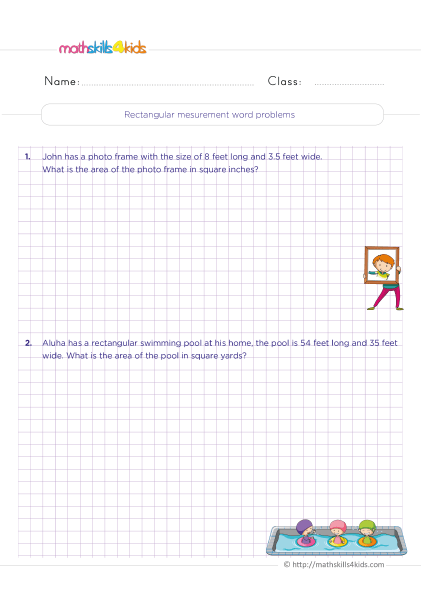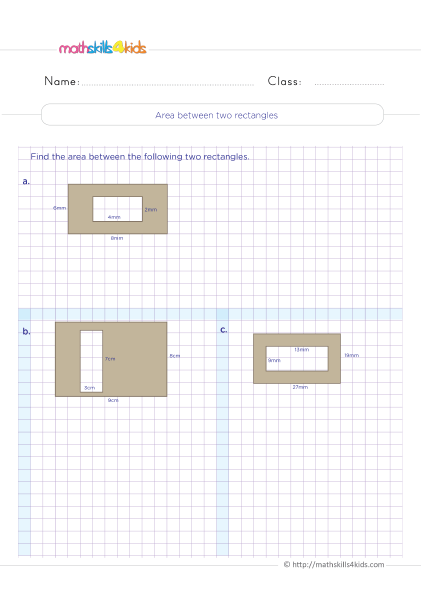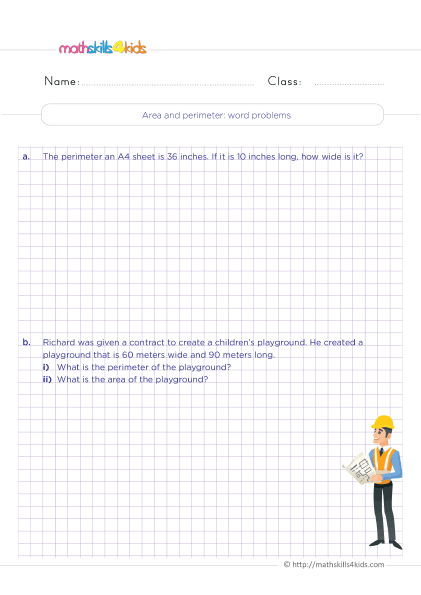Grade 4 measurement worksheets: Area, perimeter, and volume
-
Whether you're a teacher looking for new resources or a parent wanting to support your child's learning at home, our Grade 4 Measurement Worksheets are perfect for mastering these essential mathematical skills. This article will focus on building 4th graders' mastery of the area, perimeter, and volume of various shapes, attributes, and relationships.
We understand the importance of measurement worksheets in math and daily life. That’s why we invite you to visit Mathskills4kids.com, a fantastic website where you can download and print tons of thrilling Grade 4 measurement worksheets for classroom and home use.
Unlocking the Secrets of Area, Perimeter, and Volume with Grade 4 Measurement Worksheets
Are you ready to take your fourth-grade students on a journey of discovery through the fascinating world of measurement? Look no further! Our Grade 4 Measurement Worksheets are the key to unlocking the secrets of area, perimeter, and volume.
Our worksheets cover everything from calculating the area of irregular shapes to finding the volume of three-dimensional objects. But that's only part - we go beyond numbers and formulas. With real-life examples and relatable scenarios, we ensure your students understand the practical applications of measurement in their everyday lives.
-
BROWSE THE WEBSITE
-
DOWNLOAD FREE WORKSHEETS
-
-
4th GRADE MATH TOPICS
- Number sense
- Addition
- Subtraction
- Multiplication
- Division
- Mixed operations
- Variable expressions
- Functions
- Coordinate plane
- Data and graphs
- Logical reasoning
- Patterns and sequences
- Money math
- Units measurement
- Telling time
- Equivalent fractions
- Compare & order fractions
- Add & subtract fractions with like denominators
- Add & subtract fractions with unlike denominators
- Multiply fractions
- Decimals
- Add and subtract decimals
- Probabilities and statistics
- 2D shapes
- Triangles and quadrilaterals
- Symmetry
- Angles
- 3D shapes
- Geometric measurement
-
-
Find the perimeter of rectangles
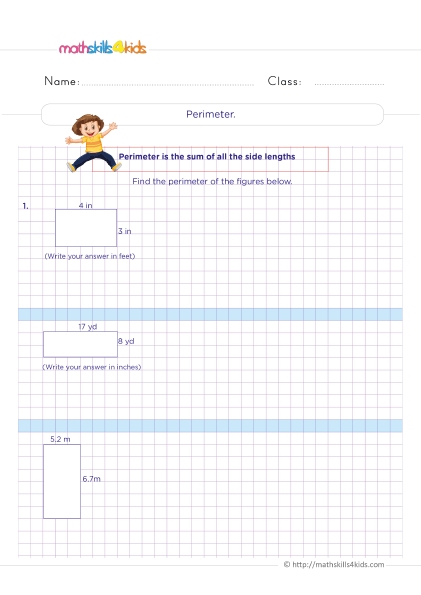 Print it...
Print it...
-
How do you find the perimeter of polygons?
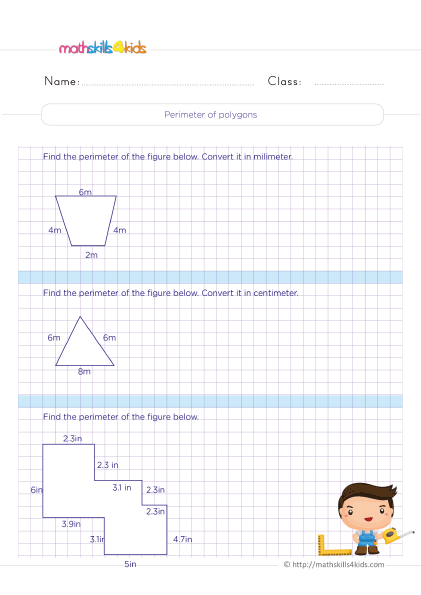 Print it...
Print it...
-
How do you find the area of figures?
 Print it...
Print it...
-
How to create figures with a given area
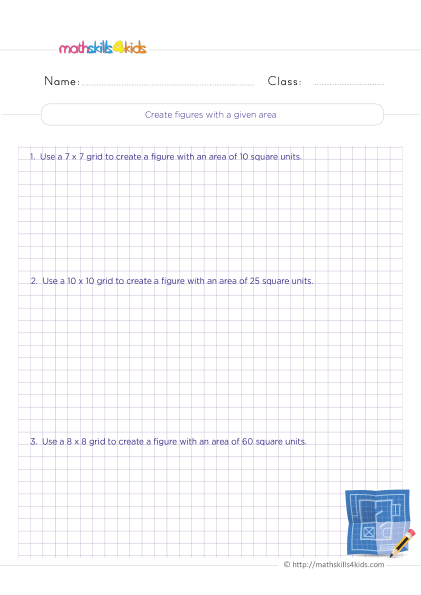 Print it...
Print it...
-
Creating rectangles with a given area
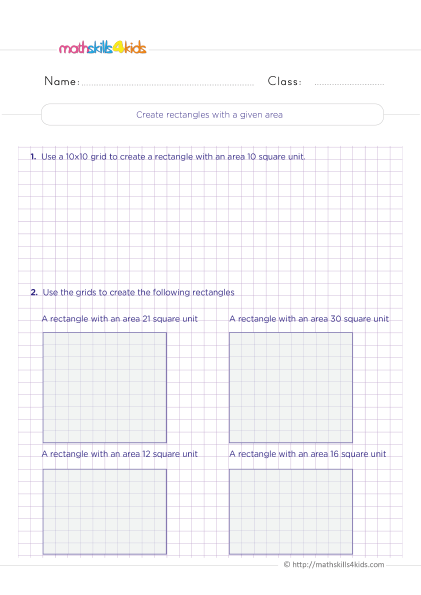 Print it...
Print it...
-
Finding the missing side length of a rectangle
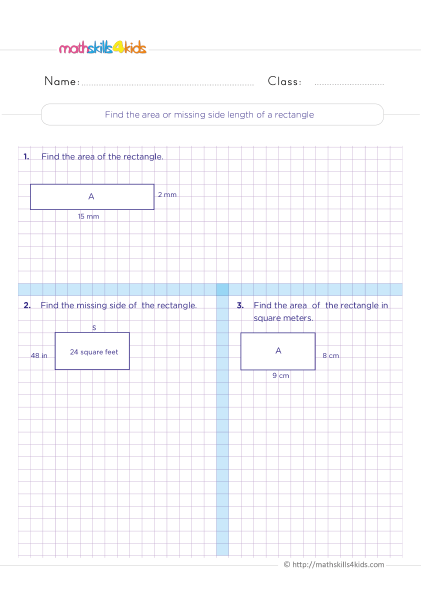 Print it...
Print it...
-
Find the perimeter of rectangles
-
Buying is supporting us!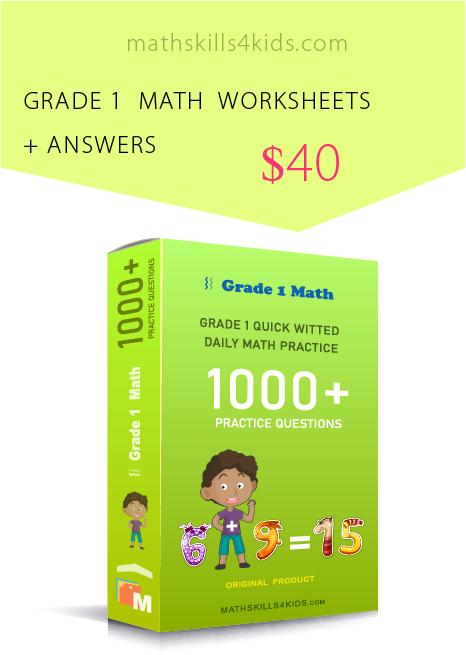
Buy Now...
-
-
Understanding area and perimeter
Before diving into the world of measurement, it's essential to understand area and perimeter clearly. Area refers to the amount of space inside a two-dimensional shape, while perimeter represents the total length of the boundary of a shape. Let's explore each concept further:
- Area: Area is calculated by multiplying the length and width of a shape. For example, to find the area of a rectangle, you multiply its length by its width. The formula for calculating the area of a rectangle is A = length x width. Similarly, the area of a square is found by multiplying the length of one side by itself, or A = side x side.
- Perimeter: Perimeter is the distance around the outside of a shape. It is found by adding up the lengths of all the shape's sides. For example, to find the perimeter of a rectangle, you add up the lengths of all four sides. The formula for calculating the perimeter of a rectangle is P = 2(length + width). Similarly, the perimeter of a square is found by multiplying the length of one side by 4, or P = 4 x side.
Since most kids find area and perimeter confusing, learning and understanding their differences is essential. Area refers to the space inside a shape, while perimeter refers to the distance around the shape. Students can confidently apply these concepts to various problems and scenarios by grasping this distinction.
-
Exploring area with grade 4 measurement worksheets
Now that we have a solid understanding of area, let's explore how our Grade 4 Measurement Worksheets can help students master this concept. Our worksheets are carefully designed to provide a comprehensive overview of area, catering to different learning styles and abilities.
Here's what you can expect from Mathskills4kids’ area-focused worksheets:
- Calculating the area of rectangles: Our worksheets provide ample practice in calculating the area of rectangles. Students will be presented with various rectangular shapes and learn to multiply the length and width to find the area. By solving progressively challenging problems, students will develop a deep understanding of the concept.
- Finding the area of irregular shapes: Our worksheets also cover calculating the area of irregular shapes. Students will be challenged to break down complex shapes into smaller, manageable parts and calculate the area of each part. This exercise promotes critical thinking and problem-solving skills while reinforcing the concept of area.
- Applying area in real-life scenarios: To ensure that students understand the practical applications of area, our worksheets include real-life examples. Students will encounter scenarios such as calculating the area of a garden, a room, or a sports field. By connecting these examples to their everyday lives, students will appreciate the relevance and importance of area in the real world.
With our Mathskills4kids’ Grade 4 Measurement Worksheets, students will gain the confidence and proficiency needed to excel in calculating area. The comprehensive coverage and practical approach of our worksheets make learning area an enjoyable and rewarding experience.
-
Introducing Volume in Grade 4 Math
As students progress through grade 4, they are introduced to the concept of volume. Volume refers to the amount of space occupied by a three-dimensional object. Understanding volume is essential as it has numerous applications in real-world scenarios, such as filling containers, measuring liquids, or estimating the size of objects. Let's dive deeper into volume:
- Measuring volume: Volume is calculated by multiplying an object's length, width, and height. The formula for finding the volume of a rectangular prism is V = length x width x height. It's important to note that the units used for length, width, and height must be the same to ensure accurate calculations.
- Unit of measurement: Volume is typically measured in cubic units, such as cubic centimeters (cm³) or cubic meters (m³). It represents the number of unit cubes that can fit inside the object. For example, if a rectangular prism has a volume of 24 cm³, it means that 24 unit cubes measuring 1 cm on each side can fit inside the prism.
By introducing volume in grade 4 math, students gain a deeper understanding of spatial concepts and develop critical thinking skills. Our Grade 4 Measurement Worksheets offer comprehensive volume coverage, ensuring students grasp the concept and its practical applications.
-
Tips for teaching and learning area, perimeter, and volume in grade 4
Teaching and learning area, perimeter, and volume in grade 4 can be an exciting and rewarding experience for educators and students. However, conveying these concepts to young minds can also be challenging. Here are some tips to help you make the learning process more engaging and impactful:
- Make it relatable: Explain how these concepts are relevant to everyday life. For example, you can discuss how knowing the area of a room can help when buying new furniture or how understanding volume can be helpful when packing a suitcase for a trip. By connecting these concepts to real-life scenarios, you can capture the students' interest and show them the practical applications of measurement.
- Use visual aids: Visual aids such as diagrams, charts, and models can significantly enhance understanding. For example, when teaching area and perimeter, you can give students grids and shapes to manipulate and measure. This hands-on approach allows students to visualize the concepts and actively participate in learning.
- Provide real-life examples: Incorporate real-life examples into your lessons to make the concepts more relatable. For instance, you can use images of famous landmarks or objects to calculate their area, perimeter, or volume. This makes the learning experience more engaging and helps students understand the relevance of these concepts in the world around them.
By implementing these tips, you can create a dynamic and interactive learning environment that fosters a deeper understanding of area, perimeter, and volume in grade 4 students.
-
Applying volume concepts with grade 4 measurement worksheets
Mathskills4kids’ Grade 4 Measurement Worksheets provide a range of exercises that allow students to apply volume concepts to various scenarios.
Here's how our worksheets can help students master volume:
- Calculating the volume of rectangular prisms: Students will practice calculating the volume of rectangular prisms using our worksheets. They will be presented with different prisms and learn to multiply the length, width, and height to find the volume. The worksheets gradually increase in difficulty, allowing students to build their skills and confidence.
- Estimating volume: Our worksheets also include activities where students need to estimate the volume of objects based on their dimensions. This exercise promotes critical thinking and helps students understand the relative sizes of different objects.
- Real-life examples: To ensure that students understand the practical applications of volume, our worksheets incorporate real-life examples. Students will encounter scenarios such as estimating the volume of a water tank, a cereal box, or a swimming pool. By connecting volume to everyday situations, students will realize the importance of this concept in their lives.
Our Grade 4 Measurement Worksheets provide a comprehensive and engaging way for students to master volume concepts. Combining practice exercises, estimation tasks, and real-life examples creates a well-rounded learning experience that prepares students for any volume-related challenge.
-
Solving perimeter problems with grade 4 measurement worksheets
Perimeter is another fundamental concept in grade 4 measurement, and our Grade 4 Measurement Worksheets are here to help students become experts in solving perimeter problems. Here's how our worksheets can assist in mastering perimeter:
- Identifying the sides of shapes: Our worksheets start by teaching students to correctly identify and label the sides of different shapes. Students can visualize and calculate the perimeter more effectively by understanding the structure of various shapes.
- Calculating the perimeter of rectangles: Students will practice calculating the perimeter of rectangles using our worksheets. They will learn to add up the lengths of all four sides to find the perimeter. Our worksheets provide a wide range of rectangular shapes, ensuring students are exposed to different scenarios and challenges.
- Finding the perimeter of irregular shapes: Our worksheets also cover the perimeter calculation for irregular shapes. Students will encounter shapes with varying side lengths and will apply their knowledge of perimeter to find the total distance around the shape. This exercise encourages critical thinking and problem-solving skills.
- Real-world application of perimeter: To make the concept of perimeter more relatable, our worksheets include real-life scenarios where students need to calculate the perimeter. They will encounter situations such as finding the perimeter of a fence, a walking path, or a room. This connection to everyday life enhances understanding and reinforces the relevance of perimeter in practical situations.
By working through our Grade 4 Measurement Worksheets, students will develop a solid foundation for solving perimeter problems. The variety of exercises, real-life examples, and gradual progression of difficulty ensure a comprehensive learning experience that prepares students for any perimeter challenge.
-
Common mistakes and misconceptions in area, perimeter, and volume
Students may encounter common mistakes and misconceptions while learning area, perimeter, and volume. Here are a few examples and tips to address them:
- Confusing area and perimeter: Students often mix up area and perimeter, thinking they are the same thing. Reinforce the difference between the two by providing clear explanations and plenty of practice exercises.
- Misusing formulas: Students may struggle with using the correct formulas for calculating area, perimeter, and volume. Please encourage them to write down the formulas and refer to them when solving problems. Regular practice will help them become more familiar with the formulas.
- Not considering units: Students sometimes forget to include units when calculating area, perimeter, and volume. Emphasize the importance of units and encourage them always to include these units in their answers.
- Misinterpreting word problems: Word problems can be challenging for students, requiring careful reading and understanding. Encourage students to read the problems multiple times, underline critical information, and identify what is being asked.
By addressing these common mistakes and misconceptions, educators can help students develop a solid understanding of area, perimeter, and volume, ensuring their success in future mathematical endeavors.
Bonus: 4th graders' additional resources for practicing area, perimeter, and volume
To further support students' learning and practice in area, perimeter, and volume, here are some additional resources specifically designed for 4th graders:
- Online interactive games: Numerous online games and interactive activities are available that allow students to practice area, perimeter, and volume in a fun and engaging way. These games often provide immediate feedback, helping students identify and correct their mistakes.
- Math workbooks: Math workbooks specifically tailored for 4th graders can be a valuable resource. These workbooks usually include a variety of exercises, ranging from simple to complex, to reinforce area, perimeter, and volume concepts.
- Math apps: Many educational apps offer interactive lessons and practice exercises for area, perimeter, and volume. These apps provide a convenient way for students to reinforce their understanding of these concepts using smartphones or tablets.
- Math manipulatives: Manipulatives such as base-ten blocks, pattern blocks, or interlocking cubes can reinforce area, perimeter, and volume concepts. Students can physically manipulate these objects to visualize and understand the concepts better.
Here are some links for more practice:
- https://www.mathplayground.com/area_perimeter.html.
- https://www.khanacademy.org/math/cc-fourth-grade-math.
- https://www.mathsisfun.com/geometry/index.html.
-
-
Thank you for sharing the links of MathSkills4Kids.com with your loved ones. Your choice is greatly appreciated.
In conclusion, mastering area, perimeter, and volume in grade 4 is essential for student's mathematical development. These concepts provide a strong foundation for future mathematical learning and practical applications in everyday life.
From calculating the area of a room to estimating the volume of a container, measurement skills are crucial for solving real-world problems.
Mathskills4kids’ Grade 4 Measurement Worksheets offer an engaging and comprehensive way for students to unlock the secrets of area, perimeter, and volume. Focusing on practical examples, real-life scenarios, and various exercises, our worksheets cater to different learning styles and abilities.
Educators can create dynamic and interactive learning environments that foster a deep understanding of these fundamental concepts by using our worksheets and following the tips provided.
So, get ready to embark on a journey of measurement discovery with our Grade 4 Measurement Worksheets from Mathskills4kids.com. Watch as your students excel in area, perimeter, and volume, and witness the transformation of their mathematical abilities.
Together, let's unlock the secrets of measurement and lay the foundation for a lifetime of mathematical success.
